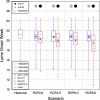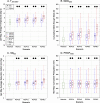Climate change influences on the annual onset of Lyme disease in the United States
- PMID: 26025268
- PMCID: PMC4631020
- DOI: 10.1016/j.ttbdis.2015.05.005
Climate change influences on the annual onset of Lyme disease in the United States
Abstract
Lyme disease is the most commonly reported vector-borne illness in the United States. Lyme disease occurrence is highly seasonal and the annual springtime onset of cases is modulated by meteorological conditions in preceding months. A meteorological-based empirical model for Lyme disease onset week in the United States is driven with downscaled simulations from five global climate models and four greenhouse gas emissions scenarios to project the impacts of 21st century climate change on the annual onset week of Lyme disease. Projections are made individually and collectively for the 12 eastern States where >90% of cases occur. The national average annual onset week of Lyme disease is projected to become 0.4-0.5 weeks earlier for 2025-2040 (p<0.05), and 0.7-1.9 weeks earlier for 2065-2080 (p<0.01), with the largest shifts for scenarios with the highest greenhouse gas emissions. The more southerly mid-Atlantic States exhibit larger shifts (1.0-3.5 weeks) compared to the Northeastern and upper Midwestern States (0.2-2.3 weeks) by 2065-2080. Winter and spring temperature increases primarily cause the earlier onset. Greater spring precipitation and changes in humidity partially counteract the temperature effects. The model does not account for the possibility that abrupt shifts in the life cycle of Ixodes scapularis, the primary vector of the Lyme disease spirochete Borrelia burgdorferi in the eastern United States, may alter the disease transmission cycle in unforeseen ways. The results suggest 21st century climate change will make environmental conditions suitable for earlier annual onset of Lyme disease cases in the United States with possible implications for the timing of public health interventions.
Keywords: Borrelia burgdorferi; Climate change; Ixodes scapularis; Lyme disease.
Copyright © 2015 Elsevier GmbH. All rights reserved.
Figures


References
-
- Archive Collaborators [17.06.14];Downscaled CMIP3 and CMIP5 Climate and Hydrology Projections. 2014 Available at: http://gdo-dc.ucllnl.org/downscaled_cmip_projections.
-
- Ashley ST, Meentemeyer V. Climatic analysis of Lyme disease in the United States. Clim. Res. 2004;27:177–187.
-
- Bailey RG. Description of the Ecoregions of the United States (Misc Publ 1391) U.S. Department of Agriculture; Washington: 1980.
-
- Brekke L, Thrasher BL, Maurer EP, Pruitt T. Downscaled CMIP3 and CMIP5 Climate and Hydrology Projections: Release of Downscaled CMIP5 Climate Projections, Comparison with Preceding Information, and Summary of User Needs. U.S. Department of the Interior; Denver: 2013.
Publication types
MeSH terms
Grants and funding
LinkOut - more resources
Full Text Sources
Other Literature Sources
Medical

